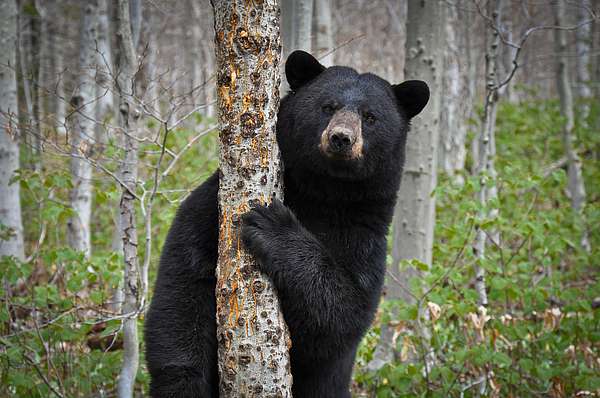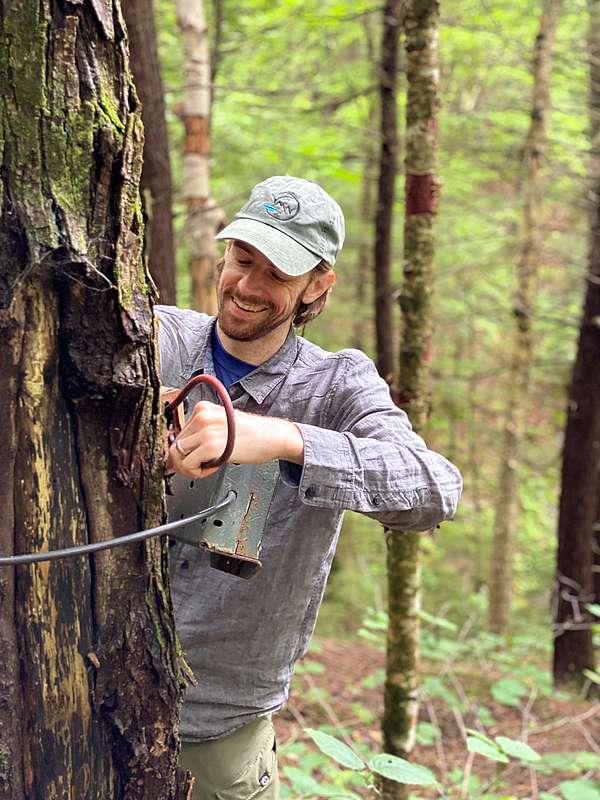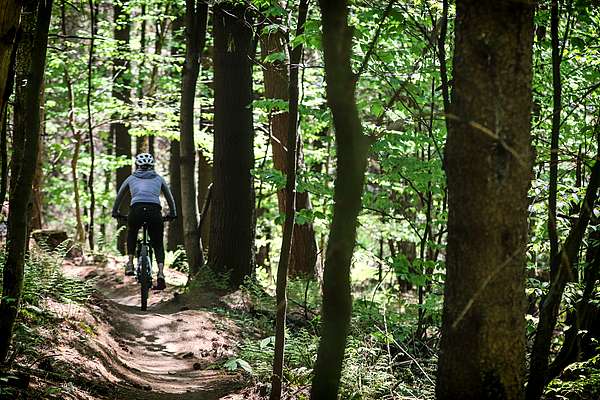Teaming up for wildlife & trails at Adams Camp
It’s 6 o’clock on a humid June morning and University of Vermont Field Naturalist graduate student, Dave Moroney is standing in the woods looking at the tree canopy and listening.
“Zee, zee, zee, zee, zee!”
“That’s a black-throated blue warbler. I love those guys,” whispers Dave. “That makes at least 15 types of forest birds who are all nesting right here at Adams Camp.” As Dave jots some notes down in his field book, he hears another set of sounds: a whir of wheels, click of gears, and call of voices.
He’s more than 100 feet from the nearest trail so he can only hear—not see—the friends passing by on Kimmers trail enjoying a morning ride through the woods. It’s a familiar back and forth at Adams Camp—the sounds of nature mixed with the sounds of play.
Hired by Stowe Land Trust to survey and map wildlife habitats at Adams Camp this summer, Dave still has a lot of ground to cover and no time to lose. Bushwhacking over to the trail, he heads toward the location of the first of eight game cameras he placed in key spots around the 513-acre parcel. So far,
he’s documented black bear, porcupine, coyote, and white-tailed deer in addition to the growing number of birds he’s witnessed.
A place where both people and wildlife can thrive
Adams Camp is part of an internationally important 722,000-acre area of connected forest that runs along the spine of the Green Mountains from south of Mount Mansfield north into Quebec. Zoom in closer and it is locally a corner of 46,000 acres of protected wildlife habitat that includes Mount Mansfield. What happens here matters for local wildlife, and impacts the big picture—especially as animals and plants are on the move in response to climate change.
But Adams Camp isn’t just a standout for wildlife. It has also been a regional recreation destination for more than a century. It is home to some of Stowe’s oldest backcountry skiing trails and has been a community hub for generations for skiers, hikers, walkers, hunters, mountain bikers, and more.
Adams Camp is privately owned by the von Trapp family, but a community-led conservation effort in 2006 allowed Stowe Land Trust, the Town of Stowe, and the Vermont Housing and Conservation Board (VHCB) to purchase a conservation easement on the property, ensuring that the land would remain forested and open to the public forever.
When Adams Camp was conserved, it was envisioned to be part of a future Vermont Mountain Bike Ride Center connecting multiple trail networks and led to the construction of the first multi-use mountain bike trails: Hardy Haul and Kimmers.
Since then, as the popularity of mountain biking has skyrocketed, Adams Camp has become a living laboratory on how to balance the creation of popular mountain bike trails with other types of recreational uses, and important ecological spaces in the same place—especially as more people want, and need to, connect with nature.
A challenging balance
Trails offer opportunities to exercise, to explore new places, and to connect with families and friends. They also allow visitors to step outside their everyday lives of home and work, and into a world shared with countless species of plants and animals.
Research has consistently shown that regular experiences in nature are also central to building a life-long conservation ethic. And for many people, including kids, trails offer a range of benefits in improving mood, physical and mental health, and well-being.
We love trails, yet no matter how familiar you are with a trail’s twists and turns, you spend your time there as a visitor, and time on the trail has an impact on the wildlife who call it home.
According to Dave, the global effort to understand the effects of recreational trails on wildlife is gathering steam. “The impact of trails varies by species, location, and trail use, and there is a lot of research still to come.” But so far, Dave says the science appears to be clear on one thing: trails can create stresses for wild animals that may result in sustained negative impacts for local populations.
Birds like the black throated blue warbler and the shy wood thrush face a changing climate, and with it extreme weather, and challenges finding adequate shelter, food, and appropriate places to raise
their young.
Add to that the impact of increasing development pressure as more and more land in the region is cut into smaller parcels, and it’s increasingly difficult for these animals to move across roads and through human neighborhoods to find what they need to survive.
Finding synergy in a special place
Long before it was officially conserved in 2006, Adams Camp was a beloved spot for dispersed recreation for more than a century. The property has been home to some of Stowe’s oldest backcountry skiing trails, and has been a community hub for generations, for skiers, hikers, hunters, and more.
Since 2006, the woods have become the site of a growing network of popular trails.
Managing public access on private land comes with unique challenges, and requires innovative strategies. In this case Stowe Land Trust, the Town of Stowe, and VHCB are tasked with overseeing recreation management at Adams Camp to ensure a balance between recreational uses, wildlife, and the health of the forest over the long run.
To do so, we collaborate with lots of partners, including Stowe Trails Partnership, who manage the multi-use trails at Adams Camp and on other conserved lands around town.
A Master Naturalist, birder, and forager, in addition to an avid mountain biker, Stowe Trail Partnership’s executive director, Carolyn Lawrence, is an enthusiastic partner in planning for the future of trails and wildlife at Adams Camp.
“Trails are a way for more people to connect with wildlife and the natural world,“ says Carolyn. “It’s well-worth the effort to make sure the trails at Adams Camp are built and managed in a way that supports important habitat while allowing responsible recreation on and growth of the trails.“
Part of what is also needed is to conserve additional land to take pressure off existing areas and conserve larger areas for wildlife and people alike. And we know that designing trails to handle extreme weather, increased wear, and more crowding at trailheads and parking areas is a long-term effort that is worth investing in.
After completing his survey this summer, Dave will help Stowe Land Trust, Stowe Trails Partnership, the Trapp Family Lodge, the Vermont Housing and Conservation Board, and the Town of Stowe facilitate the creation of an updated recreation management plan for the property which carefully considers how to weigh these important needs.
“With Dave’s help, we’re able to put a wide range of techniques to work to study, manage, and improve the health of the property,” says Stowe Land Trust Conservation Program Manager Carolyn Loeb. “From boots on the ground, in-person observation, to the latest geospatial technologies, we’re using every tool at our disposal to get an accurate read on what’s happening at Adams Camp.”
“Our commitment to conserved land lasts forever. We don’t just want to meet our base obligations to these places, we want to be leading the way when it comes to thinking about how we care for conserved properties long term.”
Balancing a wide range of community and ecological needs isn’t easy—but with input from experts, partners, trail users, landowners, and community—we will continue to protect and care for places like Adams Camp where both people and wildlife can thrive.


